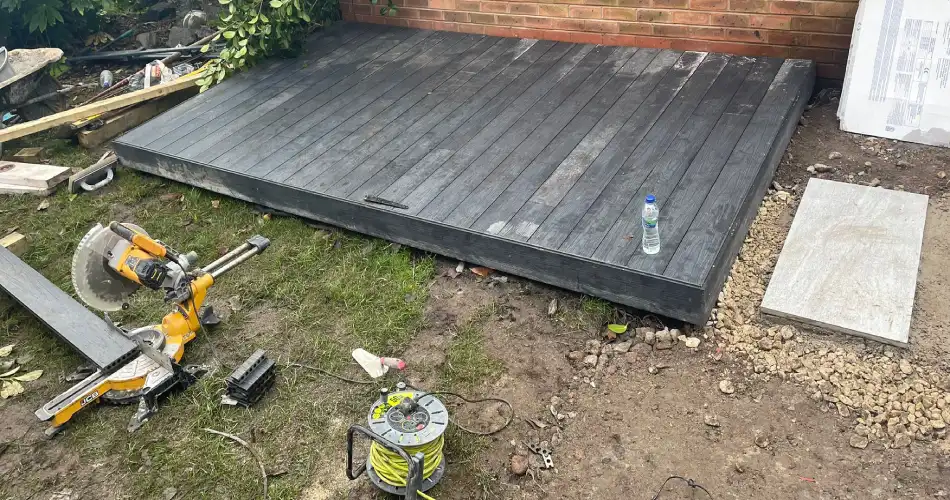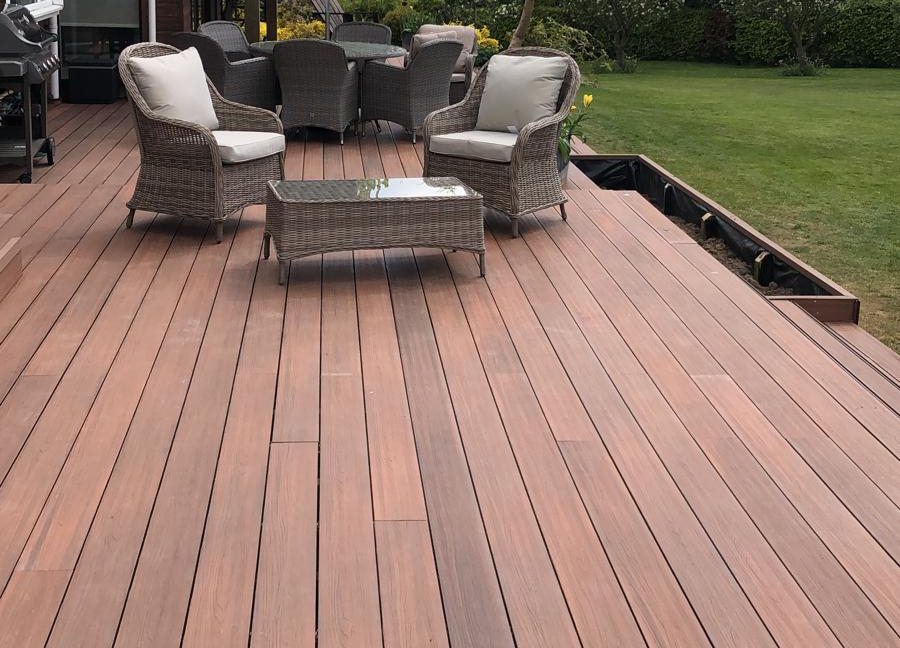What is the Life Expectancy of a Wood Decking vs Composite Decking?
Many homeowners are looking into different ways to save money while doing construction projects. This includes decking. With so many guides on the internet on how to install decking, one can accomplish it without any professional help. But one of the many concerns when building decking is the preparation of the materials, especially the decking boards. So, what is the best way to cut composite decking boards?
What Type of Saw do You Need?
When cutting composite decking boards, you will need some tools to do it. What type of saws can you use? Similar to cutting wood, you can use different types of saws depending on the cut you want to achieve.
As with wood, you can use a conventional hand saw to cut composites. But it’s not efficient and will take up a lot of time. You also need to make sure that it’s sharp. So if you are a beginner when it comes to building, now may be the best time to start investing in better tools.
A better option for cutting composites is by using a circular saw. It’s a handheld saw capable of cutting wood, plastics, and composites smoothly. However, it does take a certain amount of skill and experience to handle it by itself. The material you’ll be cutting should be held down by clamps to avoid any accidents. As far as cutting goes, it’s usable but not the best, especially for more precise cuts.
Aside from handheld circular saws, you can also use table saws. Table saws consist of a circular blade fitted under a workbench. Wood, plastic, and composite decking boards are then pushed towards the protruding saw blade, making clean and controlled cuts. It’s the most versatile among all types of saws that you can use for cutting composite decking.
Lastly, there’s the mitre saw. It consists of an adjustable saw blade that can cut precise angle cuts. It’s the best type of saw to make cross-cuts. Furthermore, it also has the most cutting accuracy among all the mentioned saw types. However, its not recommended to use this type of saw if you plan on ripping wood or composites.
Do You Need a Special Blade to Cut Composite Decking?
There are a few different types of saw blades you can use. For composite decking, you may need to use a specific type of saw blade, depending on the results you are after. For this reason, you may want to get your hands on special blades before you even start your decking project. What are some of the different types of saw blades? Which one should you use?
One way to classify saw blades is their tooth count. Depending on how many teeth a saw blade has, it will produce various cuts and be used for different materials. In general, the more teeth a saw blade has, the smoother the cuts are. What does this mean? Will it cut slower? On the other hand, the fewer the number of teeth, the more material it removes and can cut faster.
Another important factor in choosing a saw blade is its tooth angle, also known as the hook. It refers to the angle of the teeth regarding the saw blade’s centre line. There are two types of angles, positive and negative. Positive-angled saw blades have teeth leaning forward towards the rotation of the blade, whereas negative-angled saw blades have teeth angled, leaning backwards, opposite to the direction of the rotation.
Lastly, there are different saw blade tooth styles. Some types include square type, alternate top bevel, and triple chip. Each has its different purposes, namely ripping, cross-cutting, and precision cutting, respectively.
What Type of Saw Blade to Use
When starting a composite decking project, you may need to cut multiple decking boards at a faster rate without compromising accuracy. For this purpose, you may need to use mitre saws, mitre blades, and circular saws. But what type of saw blade should you use? For fast and efficient cutting, you’ll want to get a medium-duty blade. A saw with a medium tooth count (40-60) will work well for this purpose; however, if you are using the second-generation capped composite decking boards, you will need more teeth to ensure a clean, smooth cut with no hairs or plastics fibres coming off them, how do we know this, as we cut our samples and the more teeth you use when cutting capped composite decking, the better and smoother the cut and look of the sample, to provide a clean and smooth finish anything from or above 80 teeth will do perfect. You can use a medium tooth (40-60 teeth) count for first-generation boards with no capping. This is our view leaves a good finish but for the perfectionist, use a saw blade with more teeth to get the best cut and finish (80 or above teeth).
For the later steps of installing composite decking, you may need to make more precise cuts. More so if you are working to create unique decking layouts. You will also need more detailed cuts for stairs and other accessories for the decking. In this case, you will need a saw blade with more teeth.
Another thing that you might need to do is to do cross-cuts on your decking boards. Cross-cutting is the process of sawing the boards along the grains. By using crosscut saw blades, you can produce smooth cuts without splintering or tearing the boards. It’s especially useful if you plan on using grain textured composite decking boards.
Best Way to Cut Composite Decking
So, the question is, what is the best way to cut composite decking? It depends on what type of cut you are aiming for with your decking. For instance, a table saw would be perfect for the job if you want fast and efficient cuts for multiple boards. Many also use this tool to cut decking boards, both wood and composites, along the grains.
Of course, when installing decking, you may also have to make more precise and angled cuts. For this purpose, you can use a mitre saw. However, if you want the best way to cut the boards, you’ll want to use a circular saw.
Another concern is what type of blade to use; as above, we have discussed all the options; however, for this, you may want to look into the board’s manufacturer. They can give you specific instructions regarding what type of saw blades to use. But in general, blades with high tooth count (80 or above) produce smoother cuts, while fewer teeth mean faster sawing. Generally, a medium-duty blade with medium to high tooth count (40-60 teeth) works well with uncapped composite decking boards and an 80 tooth blade works well with capped composite decking.
In general, similar to wood, you can cut composite decking pretty much how you want. As long as you have the proper tools and know what you’re doing, you can create excellent decking board cuts.

How to Cut Decking Boards?
Cutting composites is similar to cutting wood. First, you will need to mark the composites where you like to cut them. Next, depending on the type of cut you want, use the appropriate saw. Make sure to observe safety at all times. For the decking edge, you may want to leave a few inches of allowance. If you do this, you can mark and cut the edge of the entire decking for a smoother and more precise cut.
Chalk
You will also need chalk to mark your decking board before cutting it. The mark will serve as a guide to make you cut your decking perfectly. You can use white chalk to make your decking. They are easier to clean off than coloured ones.
Tape Measure
Another important tool you will need to cut your decking is a tape measure. You will use the tape to measure and mark the wood or composite boards before cutting them. Ensure you mark and measure the decking correctly before you start cutting it. A good rule of thumb is to measure twice and cut once.
In addition, you will also need a clamp to hold the decking board while cutting and a square edge to create a straight mark on your decking.
Steps on How to Cut Decking Boards
Step 1
Measure and Mark Your Decking Board
The first step to take if you want to cut your decking to size is to measure the decking. Measure the board length and mark it. Mark the decking board with chalk or pencil. You must mark your wood decking straight to create a straight edge. Get a straight edge and use it to draw a straight line on the decking board. After marking your decking, proceed to cut it.
Step 2
Cut Your Decking Board
You can start cutting your decking with a circular saw. If you don’t have a circular saw, you can also use a table saw, mitre saw, or hand saw. Please bear in mind the above information on the overall cut and look depending on the tool and amount of teeth. Start cutting the boards by following the chalk mark you make on your decking.
When cutting your decking board, always leave extra length on the decking. If you cut the decking an inch longer than the exact size, you can later use a saw to cut the ends. It is better to add an inch to your decking length than to undercut your decking. When you have finished cutting the decking, start laying them.
Step 3
Install Your Decking
Now that you have finished cutting your decking boards, you can start installing them. Make use of screws or clips to fasten your decking board. Lay the decking boards side by side till you have finished laying the decking board. Then cover the board edge to make it blend well with the board. For more information upon installation, please visit our installation page.
Conclusion
You can cut your decking board to size by making use of a circular or hand saw. First, measure the board, then mark it before using a saw to cut it.
Top Tip: Measure Twice, Cut Once.
What Is Better for a Decking, Cedar or Pressure Treated?




